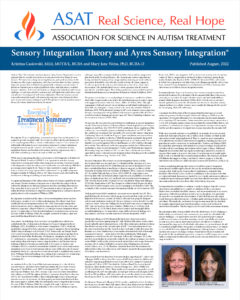Melmark authors contribute to the Association for Science in Autism Treatment (ASAT) Newsletter
The article, Sensory Integration Theory and Ayres Sensory Integration® is written by Kristina Gasiewski, MEd, MOTR/L, BCBA and Mary Jane Weiss, PhD, BCBA-D, and is now available!
Authors’ Note: This treatment summary discusses Ayres Sensory Integration®, a sensory approach that has recently been shown to be associated with some change for some learners. This represents a change in existing literature, and stands in contrast to the literature on other sensory approaches, which have not been shown to have a positive impact for autism. Still, it should be interpreted with caution for several reasons: 1) Results are limited to just a couple of published studies, and replication is needed to increase confidence; 2) Sensory interventions are designed for individuals with sensory challenges. As such, they should be used only with individuals who exhibit these issues and who have been diagnosed with sensory difficulties. (These interventions are not universally relevant for people with autism; they may have some relevance for those with documented sensory challenges); and 3) The effective treatment of autism requires the use of evidence-based interventions for autism.

Prior to highlighting the research on Ayres Sensory Integration®, we wanted to provide the reader with a brief overview of how the broader framework of Sensory Integration Theory intersects with autism treatment. It is common for individuals with autism to experience atypical responses to sensory experiences in regards to touch, sound, or smell. Interventions that are based on sensory integration theories are founded on the notion that these responses are due to difficulties modulating sensory information (Whitney, 2018).

► Click here to read the research article.
